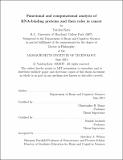Functional and computational analysis of RNA-binding proteins and their roles in cancer
Author(s)
Katz, Yarden
DownloadFull printable version (76.34Mb)
Other Contributors
Massachusetts Institute of Technology. Department of Brain and Cognitive Sciences.
Advisor
Christopher B. Burge and Rudolf Jaenisch.
Terms of use
Metadata
Show full item recordAbstract
This work is concerned with mRNA processing in mammalian cells and proceeds in two parts. In the first part, I introduce a computational framework for inferring the abundances of mRNA isoforms using high-throughput RNA sequencing data. This framework was applied to study the targets of the ubiquitous splicing factor hnRNP H in human cells. In the second part, I describe an experimental study of the Musashi (hnRNP-like) family of RNA-binding proteins in stem cells and cancer cells, which incorporates computational analyses that rely heavily on the framework developed in part one. In sum, this work provides a computational framework of general use in global analyses of RNA processing and its protein regulators, as well as functional insights into a family of poorly understood RNA-binding proteins. Several related analyses and techniques developed as part of the thesis are described in Appendix A-C. Appendix A describes a study of activity-dependent gene expression and mRNA processing in the mouse olfactory bulb. It uses computational techniques developed in part one of the thesis. Appendix B describes a technique for quantitative visualization of alternative splicing from RNA sequencing data and its integration into a genome browser. Appendix C describes a method for clonal analysis of neural stem cell growth and differentiation in culture using live imaging and `microdot' plates, developed as part of the work presented in part one of the thesis.
Description
Thesis: Ph. D., Massachusetts Institute of Technology, Department of Brain and Cognitive Sciences, 2014. This electronic version was submitted by the student author. The certified thesis is available in the Institute Archives and Special Collections. Cataloged from student-submitted PDF version of thesis. Includes bibliographical references (pages 197-200).
Date issued
2014Department
Massachusetts Institute of Technology. Department of Brain and Cognitive SciencesPublisher
Massachusetts Institute of Technology
Keywords
Brain and Cognitive Sciences.